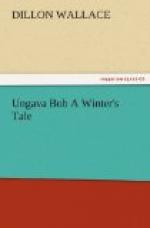The air was so filled with snow that it would be quite useless to attempt to move in it. The previous night the dogs had dug holes for themselves in the bank and were now completely covered with the drift, and invisible, and the komatik, too, was quite hidden. The aspect was dreary in the extreme, and he returned to spend the day dozing in his sleeping bag.
For two days they were held prisoners by the storm, and when finally the third morning dawned clear and cold, a deep covering of soft snow had spoiled the good going and they found travelling much slower and more difficult than the day they started.
Akonuk and Bob ran ahead on their snow-shoes to break the way for the dogs, which Matuk drove, and found it necessary to constantly urge the animals on with shouts of “Oo-isht! Oo-isht! Ok-suit! Ok-suit!” and sometimes with stinging cuts of his long whip. This whip was made of braided strands of walrus hide, and tapered from a thickness of two inches at the butt to one long single strand at the tip. Its handle was a piece of wood about a foot long and the whole whip was perhaps thirty-five feet in length. When not in use a loop on the handle was dropped over the end of one of the forward crosspieces of the komatik, and its lash trailed behind in the snow. Here it could be readily reached and brought into instant service. Matuk was an expert in the manipulation of this cruel instrument, and the dogs were in deadly fear of it. When he cracked it over their heads they would plunge madly forward and whine piteously for mercy. When he wished to punish a dog he could cut it with the lash tip even to the extent of breaking the skin, if he desired, and he never missed the animal he aimed at.
Each dog had an individual trace which was fastened to a long, single thong of sealskin attached to the front of the komatik. These traces were of varying length, the leader, or dog trained to the Eskimos’ calls, having the longest trace, which permitted it to go well in advance of the others.
For several days the journey was monotonous and uneventful. Gradually as they advanced the travelling improved again, as the March winds drifted away the soft, loose snow and left the bottom solid and firm for the dogs.
Ptarmigans were plentiful, as were also arctic hares, and a white fox and one or two white owls were killed. The flesh of all these they ate, and were thus enabled to keep in reserve the provisions they had brought with them. Bob was rather disgusted than amused to see the Eskimos eat the flesh of animals and birds raw. They appeared to esteem as a particular delicacy the freshly killed ptarmigans, still warm with the life blood, eating even the entrails uncooked.
One afternoon they turned the komatik from the land to the far stretching ice of a wide bay directing their course towards a cove on the farther side, where the Eskimos said they expected to find igloos.
All day a stiff wind had been blowing from the southwest and as the day grew old it increased in velocity. The komatik was taking an almost easterly course and therefore the wind did not seriously hamper their progress, though it was bitter cold and searching and made travelling extremely uncomfortable.




